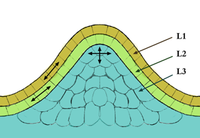
Photo from wikipedia
Diverse forms of leaves are present in nature. However, the regulatory mechanisms that underpin the development of diverse leaf forms remain enigmatic. The initiation of leaf primordia from the periphery… Click to show full abstract
Diverse forms of leaves are present in nature. However, the regulatory mechanisms that underpin the development of diverse leaf forms remain enigmatic. The initiation of leaf primordia from the periphery of shoot apical meristem (SAM) requires downregulation of the class 1 knotted-like homeobox KNOXI proteins. In plants with simple leaves, this downregulation is permanent, consistent with leaves being determinant organs. In most of plants with compound leaves, the KNOXI proteins are reactivated in developing leaf primordia, and this reactivation is required for the development of compound leaves in these plants. Surprisingly, in Medicago truncatula and pea (Pisum sativum) that belong to the so-called inverted repeat-lacking clade (IRLC) of legume plants, the KNOXI proteins are not reactivated in leaf primordia and therefore not likely involved in the development of compound leaves in these plants. Instead, the legume FLORICAULA/LEAFY orthologues, UNIFOLIATA (UNI) and SINGLE LEAFLET1 (SGL1), are required for the initiation and development of lateral leaflet primordia in pea and M. truncatula plants, respectively. On the other hand, PALMATE-LIKE PENTAFOLIATA1 (PALM1) encoding a novel Cys(2)His(2) zinc finger transcription factor is required to suppress a morphogenetic activity at the leaf margin by negatively regulating SGL1 gene expression, and FUSED COMPOUND LEAF1 (FCL1) encoding a class M KNOX protein is required for the development of the leaf proximo-distal axis and organ boundary separation in M. truncatula. Thus, these recent studies have shown that SGL1/UNI, FCL1, and PALM1 provide a genetic framework for our understanding of compound leaf development in the legume plants.
Journal Title: Methods in molecular biology
Year Published: 2018
Link to full text (if available)
Share on Social Media: Sign Up to like & get
recommendations!